Investigating whether dairy cows should be raised in pastures or barns.
Don't wanna be here? Send us removal request.
Text
(Q) Barned Cows
My most recent post explored big food companies and how they seem to be destroying the farming industry. While the documentary I watched mostly focused on the aspects of food, it also discussed the living situations of livestock. After watching this film I found that it was “healthier” for cows to be outside in pasture and feeding on grass. This came from one farmer who raises his bovines outside on his property.
Now, I want to look at a family who raises their cows in free stall barns, like the ones that I have worked on. What are the benefits of raising cows this way? Is it considered animal cruelty to keep cows inside at all times? I found a very resourceful dairy blog to help me out with explaining the answers to all these questions and more.

(Source)
The Dairy Mom blog is written by Brenda Hastings who runs a dairy farm, Hastings Dairy, alongside her husband, Lad Hastings. Brenda obtained a degree in Agriculture Business from California State University, and a Master’s Degree in Agriculture from Cal Poly State University. Lad obtained a degree in Animal Science from Ohio State University. Together they are third generation dairy producers who are located in northwest Ohio. They currently raise both of their boys on this farm, which help inspire them to host tours and group/school events in order to educate people on how to produce milk and care for cows.
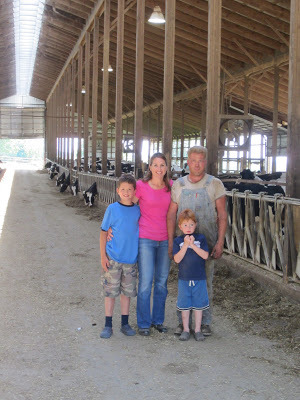
(Source)
In her blog she has posted about various topics; many of which happen to her on a daily basis. One of the posts that lead me to investigate what she was about, was entitled “Why Do Cows Live In Barns?” She goes on to explain that her incentive behind this post was that on many of her farm tours she gets people who ask this question; as well as others who accuse the family of animal cruelty.
Brenda goes on to say, “More accurate words to describe the conditions in our barns are comfortable, clean and relaxing. The cows can be seen strolling down the lane, resting in their beds, chewing their cud, drinking at the water trough with their heard mates, and having something to eat. They have the freedom to do what they want, when they want.” (Source)
Obviously, there is more than one way to raise dairy cows. Yes, when you enter a free stall barn it may at first catch you off guard. Most of the cows will be laying down in their stalls. But these stalls are not only open so that the animal has free range to get up and go as they please, they are also packed with bedding to keep the cow comfortable and dry. The bedding is usually made up of saw dust or sand.
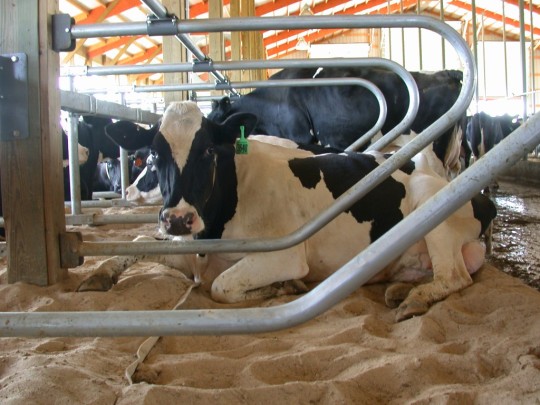
(Source)
You will find that these stalls also allow for the cow to lay in a safe place off to the side of the barn, so that the roaming cows are able to walk up and down the center isle. This also allows a place for the cows to produce their waste in an area easy for the farmer to scrape up the manure and keep the barn as clean as possible. This was one of the jobs I had while working at the dairy house. I had to use a scraper to scrape any sort of waste out of the stalls and down the center isle to an opening in the floor that lead to a well under the barn; this is where the manure would be kept until it was picked up by a waste management company.
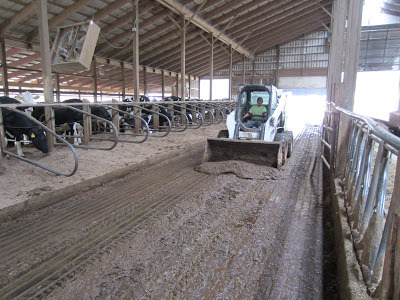
(Source)
Brenda also mentioned that barns are used to protect cows from the outside climate. Her family’s barn has numerous openings in the walls and ceiling to allow air flow to the cows. These openings can be opened or closed depending on the weather. In the winter the openings are closed to keep cows warm and safe from frostbite. In the summer they are open to allow the cows circulating air and protection from the heat of the sun.
One other positive aspect of keeping cows in barns, is that the cows’ diets are more easily monitored. Cows eat about 100lbs of feed a day and will produce about 80 gallons of milk a day. In order for all that milk to be top quality, cows need a nutrient rich diet. Brenda had mentioned that they feed their cows haylage (chopped up hay), corn silage (the entire corn plant; ear and stalk), soybean meal, wet distillers grain, fruit, ground corn and a mineral, and vitamin mix. This diet will vary depending on the cows age, where they are in the milking cycle, pregnancy status, and other factors; with the cows being in the barns, it makes it easier for the farmer to make sure there is constant food for them and to make sure the diet is as accurate as possible for the cow.

(Source)
All that I have found on Brenda Hastings’ blog, is what I, too, have experienced as a milk maid. As I have said before, cows are happy animals and I have always found this; whether it be on the farm on which I worked, or farms that I drive by every day. With my experiences, I have found that cows are also animals of routine. Our cows are sectioned into four groups, and are milked at the same times and same order every day. This is so that they know what is coming; when there are no surprises, and they are in a controlled environment, is when they seem the happiest.
I have found Brenda Hastings’ blog The Dairy Mom an extremely interesting read. She is informative and easy to follow. I highly recommend to go check it out if you have the slightest bit of interest in dairy cows. The Hasting family is a loving and wholesome family, whom I admire and aspire to be when I start a farm life of my own.
0 notes
Text
(C) Food, Inc.
In my previous post, Barcoded Cow, I broke down the image of a cow with the barcode across her belly. With a bit of research, I found that it was the cover image for the documentary “Food, Inc.”. I thought this image was meant to protest eating meat and to promote being a vegetarian, but I was wrong. I have now watched “Food, Inc.”, and my viewpoints have changed a bit. After watching this, I have realized that the farms on which I have experience working are smaller and do not have the dangerous conditions of factory farms. I thought I knew what went on behind closed doors, and I did not think anything needed to change. Due to my new insight, I think that people need to stop promoting these big factory farms by consuming foods sold at grocery stores such as Walmart; and stick to buying local family-owned produce. Not only will it be healthier with less GMO’s, but the production aspect of the food is more humane.
In Robert Kenner’s documentary “Food, Inc.” (2008) it is explained that big businesses are ruining the farming industry by mass producing unhealthy foods. He uses interviews conducted with farmers and people from corporations, footage from smaller farms and factory farms, as well as statistics to help explain the modern food industry. Kenner’s purpose is to help educate people about what happens in the background, in order to raise awareness about what consumers are eating. The documentary is calling out to the people who grocery shop and choose the cheap, packaged foods, rather than the foods that are healthier and locally grown by small family-owned farms.
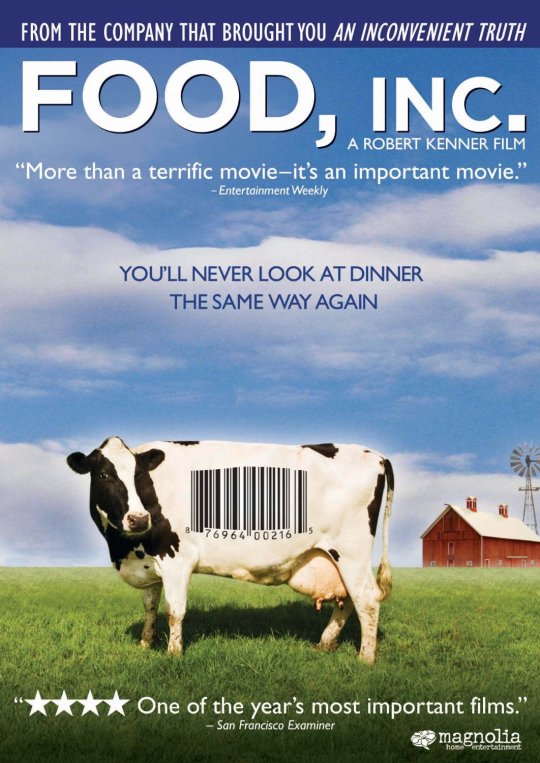
(Source)
You may be thinking, ‘Okay, what does big company food production have to do with how cows are raised?’ In actuality, it has a lot to do with that. You see, the industrial food system is always trying to be more efficient by producing bigger, faster, cheaper, and fatter foods; this includes produce and livestock.
With these new efficient ways come problems. For instance, E. coli O157:H7 was created by these big factory farms. According to Google, “E. coli O157:H7, can cause severe abdominal cramps, bloody diarrhea and vomiting”. Maybe not created intentionally, it is caused by corn mixing with the intestinal bacteria of cows. If a cow has this disease, it can taint the meat of the cow, and consuming that meat can infect, and possibly kill, human beings.
So, why would you feed corn to cows if it causes such an issue, especially when cows are meant to eat grass? As previously stated, keeping cows in one place and feeding them corn will get them to be fatter, quicker. The result is more money for the big companies, not to mention corn is a very cheap feed.

(Source)
Richard Lobb, who is part of the National Chicken Council, is one of many people who were interviewed for “Food, Inc.” He represents the big companies, trying to produce as much food as possible that will all look and taste the same. He believes that farm factories need to produce a lot of food on a small amount of land, in order to have it at an affordable price. He even says, “In a way we are not producing chickens, we are producing food.”
Later in the film they show footage of chicken barns, but the farmers are not able to let the cameras inside because of the contracts they have with the big companies. Why won’t big companies allow people to see how their food is raised? Is it because if people saw the truth they wouldn’t eat the food anymore? In some states it’s even illegal to take pictures of big company production farms. If the conditions are so horrible that you must protect your farms, why isn’t it illegal to keep the cows, chickens, and hogs that way?

(Source)
Vince Edwards is one of the farmers they interviewed; he raises chickens for Tyson. Edwards said that the chicken industry came into his community and helped to rebuild it financially. They do this by creating contracts with the farmers basically stating that the company will pay them for their crops, if the farms raise what the company wants, and how they want it raised. If a farmer breaks that contract in any way, he will no longer be able to make a living. Farmers are constantly in debt; an average chicken farm with two chicken houses will borrow about $500,000 and only make about $18,000 a year. So, if they are in production farming they need to be contracted with one of the big companies, like Tyson.

(Source)
Joel Salatin, owner of Polyface Farms, is not involved in the industry. He has a smaller farm, much like the ones I worked on; and he has no intention of expanding and losing the quality of his food. He cares for his animals, putting them to pastures and feeding grass instead of corn. He does only have a little farmer’s market, but his food is honest and wholesome. Also, when you buy from him you know the animals were treated right, and were respected.

(Source)
Some of the big companies were not happy with the fact that he does not affiliate with them, and that he does everything outside and on his property. They tried to shut him down, but when he sent his meat over to get cultures done, it came back with less bacteria than the industrial meat. So, how healthy is the food coming out of the big-time factories?
While watching “Food, Inc.” I learned that farmers aren’t the ones to blame for the abuse of animals or for the dangerous conditions that they are kept in. I learned that keeping the cows outside and having them grass fed is not only healthier for them, but also, for the consumer. All in all, I believe the best thing the people can do is to buy meat and vegetables from their local farmer’s markets, instead of buying the cheapest thing at Walmart. The healthy food is worth that extra dollar.
If you would like to find out more about this documentary, go check out it’s trailer here; if you would like to find out what other’s had to say about this film, head on over to Rotten Tomatoes’ website to check out reviews! And if you are interested in watching the entire movie, you can find it on Amazon, iTunes, and Netflix.
0 notes
Text
(B) Barcoded Cow

(Source)
When you initially look at this photograph you might experience a mixture of feelings. Sadness? Shock? Curiosity? Anger? Maybe others? This photo depicts a Holstein standing in the middle of a pasture with a barcode across her belly, almost posing as an object instead of an animal. The words “Food, Inc.” placed underneath her forcing you to pause and think about the image. Now, for me, this raised some questions; what do the words have to do with the cow? Why is she barcoded? Where are the other cows?
After I looked more closely at the image, I realized only one of the cow’s eyes are visible and it seems to be directly looking right at me. Then, everything else fell into place; this was an image meant to transform people into vegetarians, and the anger set in. I seem to always have negative thoughts about groups who make images like this. In my experiences on the farm, the people who create this kind of photograph come in as workers, but they neglect their jobs intentionally, to make the environment look worse than what it is. They then snap pictures, post them to the internet, and peg farmers as horrible and inhumane. So, I am quite biased when I come across this sort of photograph.
However, I looked past my opinion and researched the barcoded cow because I do believe that this is a powerful, and emotional, photograph. I believe it gets the people who come across it to stop and think, not only where their food comes from, but also how that food is treated up until the point it reaches the dinner table; which circles back around to my blog question “Should dairy cows be raised in barns or pastures?”
During my research, I found that “Food, Inc.” is actually a successful documentary. According to Wikipedia’s page on “Food, Inc.”, Robert Kenner’s movie “examines corporate farming in the United States, concluding that agribusiness produces food that is unhealthy, in a way that is environmentally harmful and abusive of both animals and employees”. The barcoded cow was used as the cover image for the film.
This explains why the cow is looking directly at the viewer, why it is posed as an object, why it has an emotional impact, and why the animal is all alone. The Holstein is by itself and perfectly still to give the viewer an illusion of the animal being an object. This is to make the viewer feel sympathetic towards how the animals are being treated; this can give off a sort of sadness and will make the viewer want to comply with the opinions of the documentary. This is all emphasized by the cow looking directly at the viewer, almost making them feel responsible for what happens to the animal. Overall, this image has quite a few components that make it powerful and emotional. When looking at this photograph, I can’t help but to want to find out more.
0 notes
Text
(A) Let Me Tell You A Story
Once there was a girl who loved cows; she loved them so much, she wanted one of her own. So, she worked on a local dairy farm to be educated on the care of bovine. Previously she had taken care of horses, assuming cows couldn’t be much different. However, she was surprised upon entering the dairy barn. That girl is me. Stunning, right? And so my interest in the subject of how cows are kept began.
As I have said before, I grew up around farms of all kinds: Mennonite, Amish, dairy, chicken, cattle, equestrian, family owned, and production. Most of my farm experience was with horses; until two years ago. My dad and I would ride mountain trails which were run by organizations. My aunt owned a horse, and entered my cousin in jumping competitions. I was frequently around that horse, and the ranch on which it was boarded. I also attended a summer camp where I learned how to take care of horses.

Cows, while fascinating, were foreign to me until about two years ago. My friend mentioned she worked at a dairy farm. What that entailed was unclear, but I knew I was extremely excited to find out more. So one day I went with her to milk the cows. Basically, I anticipated Old McDonald’s farm; a red barn with a few cows in the pasture which she would call in to milk. However, what I saw was unexpected.

(Source)
Multiple barns, one being larger than the rest, in order to house the cows. One hundred cows lined up in two rows. The barn was a free stall barn. To clarify, a free stall barn is when each cow has her own stall; free to stand, lay down, eat and drink. Expecting to see cows in pasture, just like horses, I was shocked at the reality. Unsure of my feelings at first, I quickly realized I felt bad. I couldn’t imagine being kept consistently in the same stall!
Next to the cow barn was the milk house where milk enters the bulk tank (an insulated container meant to cool the raw milk). This little barn stores the technology for the milk claws, as well as where they are washed. It also houses the milk filter (a system where the dirt, hair, and hay is filtered out to make the milk cleaner), along with a washer and dryer for rags.
The complexity of this process was stunning, but I was excited to learn. She made her way down the rows of cows, milking each one. We went to the calf barn to check on the calves. This was my favorite part! I loved feeding the babies; they would try and suck on your fingers which, to them, look like teats.

(Source)
Although this experience amplified my enthusiasm for working with cows, I was concerned about how the cows were housed. Obviously, these animals were not viewed as pets. Cows were rarely bathed, which is defined as hosed-down to remove big clumps of dirt. Their stalls get slippery with urine, milk, and water which will occasionally get hosed-down; adding to my shock that they remain there daily. I wanted to investigate if this was humane.
A year later, I became a milk maid. This farm was different; it was newer and had more technologies. This dairy farm was made of two barns which were connected. They housed about 340 cows; so the barn itself was pretty large. The back part of the barn was a free stall barn that was sectioned off into four parts. This allowed the cows to roam around, but still have a place to lay down. The cows would then be lead out to the milk parlor, this is the front part of the barn where the cows will be milked. Connected to the side of the parlor is the milk house.
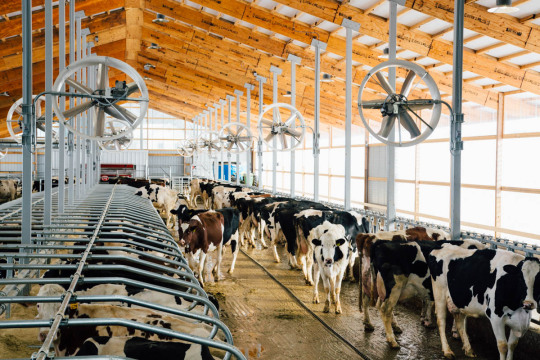
(Source)
During this job I learned more about the milking process as well as why cows are kept inside barns. I was told that I was right in thinking that cows are not viewed as pets; they are viewed as live stock. This means that the animal is there to make money, not to be a companion. They stay in the barns so that the milk builds up and becomes fattier. And they are milked three times a day so that the farmer can sell as much milk as possible.
But don’t get the wrong idea, the cows were not abused. Because they were making money for the farmer, he has to keep them in good condition. They were fed and watered well, and given any sort of medicines that they may have needed to keep them in tip top shape. The barn is just a dirty place, and cows, quite honestly, are dirty animals. That’s why they looked unkempt when I went with my friend a year prior.
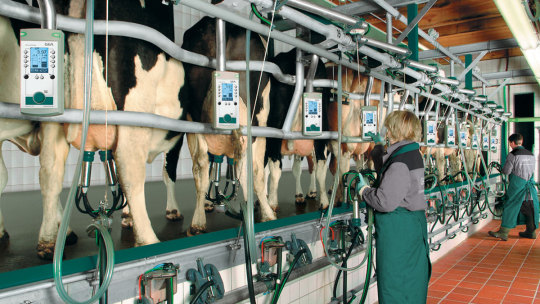
(Source)
As I became more familiar to them I started to realize they were pretty happy animals. They had a few personality traits which were similar to dogs. When you walk through them they would nudge you with their noses, try to lick your hands, and they would follow you around. When they were comfortable enough to do this around me my thoughts completely changed, these gals were so happy. They loved the routines of their daily lives, and they loved the humans they were used to.
So after this experience, my thoughts have changed a little. I still wonder if keeping them in the barn is best for them, but after seeing how they act now I wonder if cows are never introduced to the great outdoors, how do they know what their missing? So could it really be that bad?

(Source)
0 notes
Text
Welcome to Holstein Heaven

(Source)
“If happiness consisted in physical ease and freedom from care, then the happiest individual would not be either a man or a woman, it would be, I think, an American cow.” -William Lyon Phelps
How true is this statement? In my own experiences, I have found that cows are very happy animals; in fact, they have personality traits similar to dogs. However, I can see how some people would disagree. Especially with dairy cows being in barns most of their lives.

(Source)
In order to answer the question, “Should dairy cows be raised in pastures, rather than barns?”, I plan on researching the topic quite thoroughly. I will be looking at interviews, news articles, journals, and possibly other dairy blogs in order to bring myself up to date on this topic. I will be looking at both sides of the issue, so that I can find the best possible answers.
Since I grew up in Lancaster County Pennsylvania, I have quite a few farms around me, as well as people who are involved in farm life. To continue my research I plan on going out into my community and seeing what people have to say. I also plan on visiting Kreider Farms and going on one of their factory tours, in order to get a first hand glance at how production cows are kept. Since I also have my own experiences with working on farms, I would like to tie in some of that with the research that I have done.
Along the way I plan on answering other questions as well:
- Why are dairy cows raised in barns?
- What are the differences between dairy cows raised in pastures vs. barns?
- Are there differences in milk production and quality?
- What all changes occur between barn raised and pasture raised bovines?
Also, I realize that some of you may not fully understand some of the technical terms I may be using. Here are just a few definitions for general dairy terms:
-Bovine; A distinct family of ruminant mammals, referring to cattle
-Cow; Mature female bovine or dairy animal that has a calf
-Dairy cows; Cows that are raised to produce milk

(Source)
-Dairy plant; Factory that receives, tests and processes milk into dairy products
-Holstein; Breed of dairy cow that is black and white (sometimes red and white) in color
-Milk Claw; Machine that is attached to the cow’s udder whose massaging action helps the udder to release the milk
-Milk House; Sterile area at one side of the barn that stores the milking equipment and bulk tank (large, insulated container that stores and cools the milk)
-Pasture; A fenced area of land covered with grasses where animals are kept while outside
-Teat; the nipple of a mammary gland where the milk exits the body
-Udder; the mammary gland on cows where the milk is produced
(Source)

(Source)
Now lets get started, shall we?
1 note
·
View note